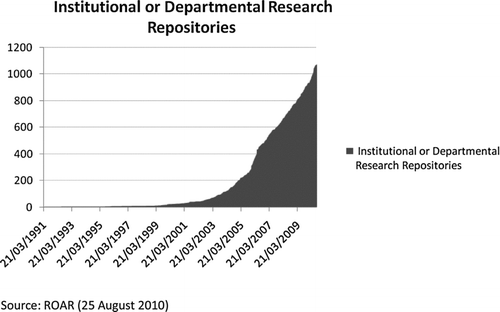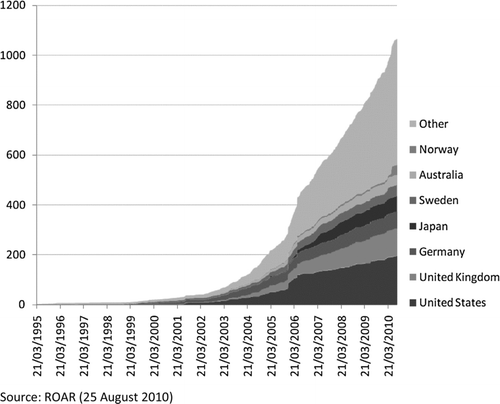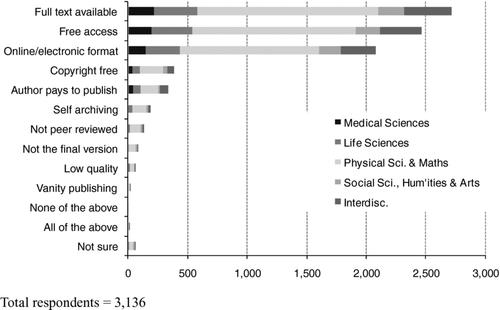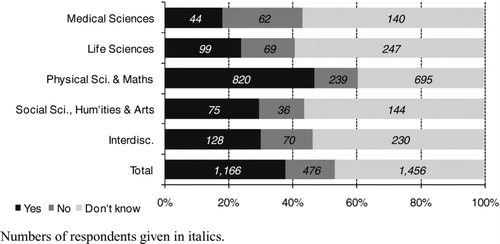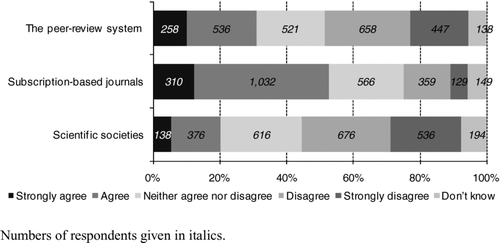Abstract
This article investigates the awareness of scholarly authors toward open access repositories and the factors that motivate their use of these repositories. The article reports on the findings obtained from a mixed methods approach which involved a questionnaire returned by over 3000 respondents, supplemented by four focus groups held across Europe in the summer 2009. The research found that although there was a good understanding and appreciation of the ethos of open access in general, there were clear differences between scholars from different disciplinary backgrounds in their understanding of open access repositories and their motivations for depositing articles within them. This research forms the first part of a longitudinal study that will track the changing behaviors and attitudes of authors toward open access repositories.
Introduction
Open access initiatives in the areas of publishing, data sharing, and repositories are shaping modes of scholarly communication (Borgman), although uptake is not uniform across disciplines (Tenopir Use and Users 45; Harley et al. 1–12). There are two main routes to Open Access: Open Access journals (“Gold Road”); and digital repositories of articles published in traditional subscription-based journals, potentially after an embargo period (“Green Road”). Rates of submission to open access repositories are variable. Some, such as ArXiv have enjoyed an early and spontaneous adoption. Others such as PubMed Central (the National Institutes of Health's biomedical and life sciences open access archive) have experienced a much slower start, hence the revision in 2008 of the NIH's 2005 Public Access policy now mandating Open Access as a condition of funding to foster deposit. Both ArXiv and PubMed Central are now widely used and a valuable resource to researchers in physics and mathematics, and biomedical sciences respectively, as are RePEc for economics and SSRN covering a wide range of social science disciplines. Other discipline-specific or institutional repositories are generally reporting lower levels of uptake and, to some extent, have not fully become part of the established workflow for researchers. With regards to institutional repositories, deposit rates are notably low, hence the worldwide rise of institutional mandates to encourage researchers to make their work available on open access.
The focus of this article is authors’ perceptions of repositories, and the influence of those perceptions on their publication and dissemination behaviors. In exploring authors’ perceptions and behaviors, a particular emphasis has been placed on similarities and differences between disciplinary areas. It is beyond the scope of this article to provide a comprehensive overview of the repository landscape and related self-archiving mandates, and therefore only a brief introduction is provided in this article. The current repository landscape can be reviewed by looking at sources such as OpenDOARFootnote 1 and ROARFootnote 2 , which provide detailed faceted analysis of current repository population, as well as ROARMAPFootnote 3 which provides a list of operational self-archiving mandates.
Background
Open Access and Repositories
A strong argument has been made that the benefits of Open Access include greater access to scholarly literature, faster dissemination of new knowledge, greater research impact, and increased citation rates (Swan “Open Access and the Progress” 198–200; Harnad and Brody n.pag.; Swan The Open Access Citation Advantage 1–17).
For some disciplines, a self-archiving model would be a radical departure from current publishing workflows. In others, self-archiving has become the norm. The physics and economics communities, for example, have a long tradition of self-archiving pre-prints (papers before peer review) to support rapid dissemination and to establish priority over ideas. ArXiv has dominated the subject-based repository landscape since the 1990s and RePEc is well established within economics, but very few subject-based repository initiatives have managed to replicate their success. The success of PubMed Central is possibly the result of two joining forces, the implementation of the NIH mandate and the adoption of a variation on the self-archiving model; in that publishers automatically deposit articles on behalf of authors, as well as accepting articles from individual researchers.
Institutional repositories are comparatively new. They are the result of a combination of factors including the Open Access movement gaining momentum at the turn of the 21st century, drastic increases in journal prices since the 1990s and increasing pressure on higher education institutions to compete for research funds through periodic research assessment. It is only in the past five years that institutional repositories have begun to emerge worldwide (). A 2008 study, conducted as part as of the DRIVER project, concluded that half of European universities had an institutional repository (Vernooy-Gerritsen et al. n.pag.). Uptake varies between countries (), with some, such as the UK, having a repository in almost every university. In the UK the ECS EPrints repository (Department of Electronic and Computer Science, University of Southampton, UK) stands out as an exemplar, as one of the first repositories worldwide to receive deposits of research outputs under a self-archiving mandate (introduced in 2001). The growing pressure on Higher Education institutions to promote their research and measure its impact, has led to an ongoing debate concerning the interrelationship between institutional repositories, research evaluation (of individual academics, research groups, departments and institutions), and subject repositories.
Repository by Content Type
Scholarly Communication and Information Behaviors
Peer-reviewed journals have traditionally been the main medium supporting scholarly communication, especially in the sciences. The advent of electronic publishing and networked communication has opened new ways for scholars to communicate and disseminate their findings to their peers. Although publication in peer reviewed journals remains an essential requirement to disseminate findings, achieve peer recognition, and for career advancement, scholars now have additional channels enabling their publications to get more research impact, greater readership, and visibility. Open Access repositories are possibly one of the most interesting dissemination channels available to scholars today.
Scholars expect easy online access to a wide range of journals from their desktop—and beyond. Tenopir et al. (“Electronic Journals” 8) have indicated that journal articles constitute the first source of information for scholars, supported by the significant increase in reading over the last decade, with an average of 280 journal articles read per year against 216 in 2000–02 and 150 in 1977. Almost half (48.5%) of these readings are for research purposes, with a further 10.8% used in research-related activities such as writing articles, reports, or funding proposals (Tenopir et al. “Electronic Journals” 5–32). There exist variations between researchers in their reading and information seeking patterns Tenopir et al. (“Variations in Article” 139–148), often correlated to disciplinary practice. Tenopir et al. (“Variations in Article” 144–146) also indicated that work responsibilities, career stage, or productivity may influence scholars’ information seeking and reading behaviors.
Method
This article is based on mixed methods research, comprising a web-based survey of European researchers and a series of disciplinary focus groups. Four broad disciplinary headings were used to categorize survey respondents and to select focus group participants: Medical sciences; Social sciences, humanities, & arts; Life sciences; and Physical sciences & mathematics (including engineering). Data were collected in June to August 2009, as part of the PEER funded project “Behavioural research: authors and users vis-à-vis journals and repositories” (Fry et al. i–93). PEERFootnote 4 (Publishing and the Ecology of European Research) is an experiment to investigate the effects of the large-scale, systematic deposit of authors’ final peer-reviewed manuscripts (also called stage-two manuscripts) on reader access, author visibility, and journal viability, as well as on the broader ecology of European research. The aim of this project is to understand the extent to which authors and users are aware of open access, the different ways of achieving it, and the (de)motivating factors that influence its uptake.
The Survey
A web-based survey of researchers was created, informed by background research. It included questions addressed to scholars both as writers of research outputs and as readers or consumers of those outputs, and focused on research dissemination via journal articles. The survey was piloted with a small number of researchers spread across Europe, and one based outside Europe. Invitations to complete the survey were distributed by the 12 publishers participating in the PEER experiment to EU-based authors who have had articles published in at least one of the 300 jounrnalsFootnote 5 participating in the PEER experiment since January 2008. The participating publishers collectively volunteered the 300 journals (covering the Life sciences, Medicine, Physical sciences, Social sciences & humanities & other professional publications); which represent good quality journals across a range of Journal Impact Factors.
Characteristics of the Survey Sample
A total of 3,139 valid responses were received, covering all countries in the EU. More than 100 responses were received from each of seven countries (UK, Germany, Italy, Spain, France, the Netherlands, and Sweden). The largest single group of respondents had been employed in research for between 5 and 14 years. Seventy percent were based in universities or colleges, with a further 20% based in research institutes. As part of the analysis, respondents were divided into disciplinary groups—more than half of all respondents were from the Physical sciences & mathematics. Respondents were allocated to an Interdisciplinary group if they ticked subjects from two or more disciplinary areas. It is not clear whether the bias towards Physical sciences & mathematics was inherent in the initial distribution of the survey or whether researchers in these disciplines were more likely to respond to such a survey.
The Focus Groups
Four focus groups were held, in London, Berlin, Budapest, and Rome, so as to attract participants from a variety of Open Access contexts. Each focus group mapped onto one of the broad discipline areas noted previously. All were conducted in English and each was facilitated by three members of the research team. The focus groups were conducted through the use of four scenarios, of which two aimed to investigate researchers’ views as authors and two explored their views as readers.
The focus groups were audio-recorded and later transcribed in full. The data were coded and categorized, using a scheme developed iteratively based on themes from the related literature and themes that emerged from the data. Each participant was sent a copy of the analysis to check that their views had not been distorted or misinterpreted.
Characteristics of Focus Group Participants
Participants were at varying stages of their careers, although mid-career and senior researchers predominated. The Social sciences, humanities, & arts focus group comprised relatively senior researchers from a broad range of disciplines, including law, sociology, gender studies, and semiotics. The Medical sciences focus group comprised researchers who were generally at earlier stages of their careers in the fields of immunology, anatomy, ethno-botany, and pharmacology. In the Physical sciences & mathematics focus group, the majority of participants were physicists, but structural engineering and chemistry were also represented. Participants ranged from very senior members of the physics community to early career researchers. The Life sciences focus group involved participants from a broad range of disciplines, most of whom were mid-career to senior researchers.
Findings and Discussion
Awareness of Open Access
Authors were familiar with the term Open Access, with focus group participants, and more than two thirds of survey respondents, demonstrating a general understanding of the concept, at least in its most simple form: free electronic access to the full-text of articles. Only a small number of authors (less than 5% of survey respondents) had an unfavorable view of Open Access, for example considering it to mean low quality, not peer reviewed, not the final version of an article, or vanity publishing (). Authors from the Social sciences, humanities, & arts were more likely to be unsure about the meaning of Open Access.
In terms of authors’ appreciation of the difference between the Open Access models, only six percent of authors surveyed associated Open Access with self archiving, with a slightly higher percentage (11%) associating it with an “author pays” model. The relatively low levels of association between Open Access and self-archiving perhaps reflects the anecdotal evidence presented by Swan and Brown (43–49) that the majority of authors are unlikely to go down the self-archiving route voluntarily to make their research works freely available online.
In terms of levels of awareness across disciplines, authors in the Medical sciences, Life sciences, and Interdisciplinary areas were more likely to associate Open Access with the “Gold Road” than researchers in the Physical sciences & mathematics and Social sciences, humanities, & arts areas. Correspondingly, authors from the Medical sciences and Life sciences were less likely to associate Open Access articles with not being peer reviewed, and not being the final published version, than those in the Physical sciences & mathematics and Social sciences, humanities, & arts.
Awareness and Use of Repositories
Levels of Open Access awareness do not necessarily equate to levels of repository awareness. For example, authors participating in the focus groups tended to associate Open Access with the “Gold Road.” Authors were asked to name suitable subject-based repositories and in some cases the “repositories” named were, in fact, Open Access journals and/or publishers (e.g., Biomed Central, PLoS).
Some focus group participants found the term “repository” confusing—most expressed some difficulty in defining what a repository was and what sort of material it might hold (peer-reviewed articles, pre-prints, data, etc.). Some understood repositories to hold only working article series or pre-prints and were somewhat taken aback by the idea of submitting published articles to an institutional repository and may be attributable to the fact that institutional policies vis-à-vis repositories tend to vary greatly. While some institutional repositories focus on published articles, others have a broader remit and may even accept multimedia items. Such uncertainty was observed in each focus group and the free text responses provided by survey respondents who often simply conflated repositories with journals in terms of an outlet for dissemination.
Although 46% of authors expressed a preference for depositing in subject-based repositories, compared to 22% preferring an institutional repository; only 37% of respondents knew of a suitable subject repository they could use. Just over half of the authors surveyed had deposited a peer-reviewed journal article in a repository in the past five years.
Disciplinary Differences
Authors from Physical sciences & mathematics expressed a stronger preference for subject-based repositories, while authors from the Social sciences, humanities, & arts were more likely to have deposited in an institutional repository than any other disciplinary group. Awareness of subject-based repositories varied between disciplines (). Authors who participated in the Medical sciences and Life sciences focus groups demonstrated a lack of awareness of subject-based repositories suitable for their research outputs, despite the centrality of PubMed Central to their information seeking behaviors. This finding signifies a discontinuity in perceptions of repositories between researchers as authors and as readers, with preferences shifting depending on whether researchers are in dissemination mode or information seeking mode. Authors in the Social sciences, humanities, & arts focus group were least familiar with subject-based repositories, either as authors or information seekers.
Disciplinary differences in dissemination and publication workflows, which, according to focus group participants, are rarely formalized, are likely to influence researchers’ awareness and use of repositories. For example, the uptake of subject-based pre-print repositories in the 1990s by physicists means that authors in these disciplines are used to self-archiving papers at the same time as, or even before, submitting them to journals. Among the authors surveyed, those from the Physical sciences & mathematics were more likely to have deposited an article to a repository in the past five years than any other disciplinary group. Physics focus group participants explained that self-archiving is the “norm” and, therefore, is part of the day-to-day workflow.
By contrast, despite an increasing number of medical research-funded mandates (SQW Consulting and LISU 49), the survey found that authors from the medical sciences were least likely to have deposited articles in the last five years. There are two possible reasons for this: first, authors who actively wish to make their research openly accessible have a range of high quality “author pays” journals available to them (e.g., PLoS Medicine); and second, many publishers of medical journals deposit material into PubMed Central themselves, obviating the need for authors to perform this task.
Motivations and Barriers
Motivations
Disseminating outputs as widely as possible was a key driver for self-archiving among the authors surveyed (). Focus group participants considered the benefits to include greater visibility, increased citation rates, and reputation building. Social sciences, humanities, & arts authors were more likely to rate increased citations as “very important” than those from other disciplines. Authors in the Medical sciences and Physical sciences & mathematics indicated that career advancement was a less important motivator for depositing in an open access repository, than authors in other disciplinary areas.
FIGURE 5 How important are the following factors, or would the following factors be, in encouraging you to place peer-reviewed journal articles in a publicly available repository?
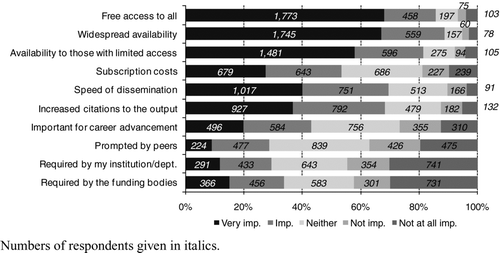
Of those authors surveyed who had deposited a stage-two manuscript, 70% reported that they did so voluntarily. The most frequently cited motivations to deposit included: suggestion from a colleague (12% of those who had deposited); invitation from the repository in question (11%); request from a co-author (10%); publisher invitation to deposit (8%); mandated by institution (8%); and funder mandate (3%)Footnote 6 . Authors participating in the focus groups had strong opinions concerning funder or institutional Open Access mandates. They acknowledged the potential benefits of making outputs publicly available on the one hand, but felt that they had received mixed messages from funders and institutions, on the other. Furthermore, they felt that there was a conflict between Open Access mandates and the increasing pressure placed on them by institutions to publish in high impact factor journals. These findings indicate that the effectiveness of funder/institutional mandates and researchers’ awareness of them need to be explored further.
There were notable differences in the importance of different motivations expressed by survey respondents according to disciplinary area. Respondents in the Life sciences were more likely to rate the principle of free access to all as “very important,’ while speed of dissemination was perceived as less important for respondents in the Medical sciences than those in other areas, such as Physical sciences & mathematics where it was highly rated. Mandates, by the institution or the funder, were more likely to be rated as “not at all important” by respondents from the Physical sciences & mathematics than those in other subjects.
Peer-review is seen as an important mechanism for validation of results, and focus group participants from the Medical sciences explained that papers that have not been peer-reviewed would be treated with skepticism. In contrast, physicists and mathematicians favored speed of dissemination over peer-review. This may be explained by the system of internal peer-review that is in place in many physics’ collaborations, in particular those that are focused on the experiments based at particle accelerator sites, such as Atlas at CERN. Additionally, physicists participating in the Physical sciences & mathematics focus group described a research culture that encouraged authors to disseminate their findings early, to establish priority.
Barriers
The three most frequently cited concerns regarding depositing in an Open Access repository among the authors surveyed were: concerns over copyright infringement; uncertainty over embargo periods; and unwillingness to place outputs where other content had not been peer reviewed. These findings are consistent with those of Creaser (16–17) and are clearly enduring concerns. Interestingly, a lack of knowledge of how to deposit material was the second most important concern to authors in the Medical sciences, with concerns regarding infringing embargo periods coming much further down the list. The different priority of concerns expressed by authors in the Medical sciences is consistent with the dissemination and publication workflows described previously.
Focus group participants emphasized concerns regarding infringement of publishers’ copyright. It is not clear to authors what their rights are once they have signed a Copyright Transfer Agreement with the publisher. Furthermore, authors tend to have a highly restrictive view of copyright permissions relating to pre-prints and post-prints. Significantly, they were unaware that a growing number of publishers support open access by allowing the deposit of stage-two manuscripts in repositories. Authors were also unaware of the Sherpa/RoMEOFootnote 7 service that provides repository administrators and authors with information regarding publishers’ self-archiving policies and the permissions they grant to authors to disseminate different versions of a published article. Changing the terms of Copyright Transfer Agreements was not common practice among authors in the focus groups, with early career researchers particularly reluctant to do this.
If potential depositors are assured that the copyright status of submissions will be checked against services such as SHERPA/RoMEO as part of the submission process, then this may reduce their fears. Our findings also suggest that explicit notification from journal publishers that deposit is permitted (as in the PEER experiment) could also improve levels of deposit.
Impact of Repositories on Dissemination and Publication Behaviors
Open Access repositories are often presented by open access enthusiasts and evangelists as an optimal model for scholarly communication. Anecdotal evidence suggests that publishers have shown concern that a journal's financial viability could be challenged by the uptake and use of Open Access repositories. The Open Access movement has raised questions regarding the role of journals in scholarly communication and the value that they add, through the range of services they offer, to scholars’ papers and scholars’ peer review work.
Our findings show that scholars are receptive to Open Access and, although they do not always grasp the detail, they can see a potential for repositories in scholarly communication. It remains unclear what this role entails, as scholars have concerns which need to be addressed first. Only 4% of survey respondents thought that there was no role for repositories. Just over half of survey respondents (53%) perceived repositories as challenging the predominance of subscription-based journals in scholarly communication (). Information seeking and reading behavior studies have shown that scholars highly rate scholarly journals. Our findings indicated that scholars highly value the role of journals in the widespread dissemination of their research, as well as in building up their own reputation through the reputation of the journal itself. Journals constitute over 90% of scholars’ information sources (Tenopir et al. “Electronic Journals” 8; King et al. 127), and studies have shown that the amount of reading of scholarly journals for research purposes has increased over time, particularly in the context of digital full-text aggregated literature databases. Interestingly, there was perceived to be less threat on the peer review system, with only 31% of respondents thinking that repositories could challenge peer review (). While scholars’ attachment to peer review was strongly expressed in the focus groups, the overall findings of our study suggest that scholars could foresee the possibility of peer review being organized and managed outside scholarly journals. It remains to be seen what form this peer review might take, but some of the Web 2.0 tools could help develop new ways of organizing peer review in the same way scholarly skywriting (Harnad 342) has changed informal scholarly communication and peer interaction.
Further Research
This research has highlighted a number of issues that require investigation in more depth. The related literature has shown that the acceptance of Open Access among researchers is increasing, albeit varying greatly by discipline. Our findings identified an ethos among authors in support of Open Access, which corroborates this trend. In particular, authors were supportive of Open Access repositories. The extent to which that ethos might be leveraged into increased rates of self-archiving is, however, unclear.
While it is difficult, if not impossible, to attribute behavioral changes among authors to a single factor, it will be interesting to explore these issues in more depth in Phase 2 of the PEER “Behavioural research: authors and users vis-à-vis journals and repositories.”
Acknowledgements
The authors would like to thank the PEER Executive for funding this work, as part of the PEER Observatory project (http://www.peerproject.eu/). The authors would also like to thank Chris Armbruster for his comments on an earlier version of this article.
Notes
5. A list of participating journal publishers can be found at http://www.peerproject.eu/about/
6. Respondents could mark more than one answer to this question.
References
- Borgman , Christine. L. 2007 . Scholarship in the Digital Age: Information, Infrastructure, and the Internet , Cambridge, MA : MIT Press . Print
- Creaser , Claire . 2010 . Open Access to Research Outputs—Institutional Policies and Researchers’ Views: Results from Two Complementary Surveys . New Review of Academic Librarianship , 16.1 : 4 – 25 . Web. 18 Mar 2010. <http://www.informaworld.com/smpp/content~content=a919646948~db=all~jumptype=rss>
- Fry , Jenny , Creaser , Claire , Greenwood , Helen , Oppenheim , Charles , Probets , Steve , Spezi , Valérie and White , Sonya . Sept 2009 . PEER Behavioural Research: Authors and Users vis-à-vis Journals and Repositories [Baseline report] . Web. 18 Mar 2010. <http://www.peerproject.eu/fileadmin/media/reports/Final_revision_-_behavioural_baseline_report_-_20_01_10.pdf>
- Harley , Diane , Krzys Acord , Sophia , Earl-Novell , Sarah , King , C. Judson and Lawrence , Shannon . 2008 . Assessing the Future Landscape of Scholarly Communication: An In-depth Study of Faculty Needs and Ways of Meeting Them , Centre for Studies in Higher Education, UC Berkeley . Web. 18 Mar 2010. <http://cshe.berkeley.edu/publications/publications.php?id=300>, Interim Report
- Harnad , Stevan and Brody , Tim . 2004 . “Comparing the Impact of Open Access (OA) and Non-OA Articles in the Same Journals.” . D-Lib Magazine , 10.6 Web. 18 Mar 2010. <http://www.dlib.org/dlib/june04/harnad/06harnad.html>
- Harnad , Stevan . 1990 . Scholarly Skywriting and the Prepublication Continuum of Scientific Inquiry . Psychological Science , 1 : 342 – 343 . Web. 18 Mar 2010. <http://www.jstor.org/pss/40062820>
- King , Donald W. 2009 . Songphan Choemprayong, Carol Tenopir, and Lei Wu. “Scholarly Journal Information-seeking and Reading Patterns of Faculty at five US Universities . Learned Publishing , 22.2 : 126 – 144 . Web. 18 Mar 2010. <http://www.ingentaconnect.com/content/alpsp/lp/2009/00000022/00000002/art00008;jsessionid=rewtiryoy2c2.victoria>
- SQW Consulting, and LISU . 2008 . Open Access to Research Outputs , Report to RCUK, Swindon Web. 18 Mar 2010. <http://www.rcuk.ac.uk/cmsweb/downloads/rcuk/news/oareport.pdf>
- Swan , Alma . 2007 . Open Access and the Progress of Science . American Scientist , 95 : 198 – 200 . Print
- Swan , Alma . 2010 . The Open Access Citation Advantage: Studies and Results to Date , Technical Report, School of Electronics & Computer Science, University of Southampton . Web. 18 Mar 2010. <http://eprints.ecs.soton.ac.uk/18516/>
- Swan , Alma and Brown , Sheridan . 2005 . Open Access Self-archiving: an Author Study , Truro, , UK : Key Perspectives Limited . Web. 18 Mar 2010. <http://www.jisc.ac.uk/media/documents/themes/infoenvironment/oaselfarchivingauthorstudy.pdf>
- Tenopir , Carol . 2003 . Use and Users of Electronic Library Resources: an Overview and Analysis of Recent Research Studies , Washington, D.C. : Council on Library and Information Resources . Web. 18 Mar 2010. <http://www.clir.org/pubs/abstract/pub120abst.html>
- Tenopir , Carol , Edwards , Sheri , King , Donald W. and Wu , Lei . 2009 . Electronic Journals and Changes in Scholarly Article Seeking and Reading Patterns . Aslib Proceedings New Information , 61.1 : 5 – 32 . Web. 18 Mar 2010. <http://www.emeraldinsight.com/Insight/viewContentItem.do;jsessionid=80DEF3F7F49FBD253103C5E140B35AD9?contentType=Article&contentId=1766871>
- Tenopir , Carol , King , Donald W. , Spencer , Jesse and Wu , Lei . 2009 . Variations in Article Seeking and Reading Patterns of Academics: What Makes a Difference? . Library & Information Science Research , 31.3 : 139 – 148 . Web. 18 Mar 2010. <http://dx.doi.org/10.1016/j.lisr.2009.02.002>
- Vernooy-Gerritsen , Marjan , Pronk , Gera and Van DerGraaf , Maurits . 2009 . Three perspectives on the evolving infrastructure of institutional research repositories in Europe . Ariadne , 59 Web. 18 Mar 2010. <http://www.ariadne.ac.uk/issue59/vernooy-gerritsen-et-al/>
